标签:
1.1 Map.clear方法——从Map集合中移除所有映射关系
public static void main(String[] args) {
Map map=new HashMap(); //定义Map集合
map.put("昨天", "定制目录"); //向集合中添加元素
map.put("今天", "开始写作");
map.put("明天", "当然继续写作");
System.out.println("map大小为:"+map.size()); //输出集合大小
map.clear(); //清除Map集合的所有内容
System.out.println("清除内容后的map大小是:"+map.size());
}
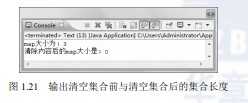
1.2 Map.containsKey方法——判断Map集合对象中是否包含指定的键名
public static void main(String[] args) {
Map map = new HashMap(); //定义Map对象
map.put("apple", "新鲜的苹果"); //向集合中添加对象
map.put("computer", "配置优良的计算机");
map.put("book", "堆积成山的图书");
map.put("time", new Date());
String key = "book";
boolean contains = map.containsKey(key); //判断是否包含指定的键值
if (contains) { //如果条件为真
System.out.println("在Map集合中包含键名" + key); //输出信息
} else {
System.out.println("在Map集合中不包含键名" + key);
}
}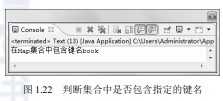
1.3 Map.containsValue方法——判断Map集合中是否包含指定的键值
containsValue(Object value)
value:要查询的Map集合的指定键值对象。
public static void main(String[] args) {
Map map = new HashMap(); //定义Map集合对象
map.put("apple", "新鲜的苹果"); //向对象添加元素
map.put("computer", "配置优良的计算机");
map.put("book", "堆积成山的图书");
map.put("time", new Date());
try {
Thread.sleep(1000); //休眠1秒,使两个Date对象不相等
} catch (InterruptedException e) {
e.printStackTrace();
}
Date value = new Date(); //创建日期时间对象
boolean contains = map.containsValue(value); //判断集合中是否包含指定的value值
if (contains) { //如果条件成立
System.out.println("在Map集合中包含键值" + value); //输出信息
} else {
System.out.println("在Map集合中不包含键值" + value);
}
}

1.4 Map.equals方法——判断Map集合是否与指定的对象相同
public static void main(String[] args) throws InterruptedException {
Map map1 = new HashMap(); //定义Map集合对象
map1.put("apple", "新鲜的苹果"); //向集合中添加对象
map1.put("computer", "配置优良的计算机");
map1.put("book", "堆积成山的图书");
Map map2 = new HashMap();
map2.put("apple", "新鲜的苹果"); //定义Map集合对象map2
map2.put("computer", "配置优良的计算机");
map2.put("book", "堆积成山的图书");
boolean contains = map1.equals(map2); //判断集合是否相等
if (contains) {
System.out.println("两个Map对象相同");
} else {
System.out.println("这不是两个相同的Map对象");
}
}
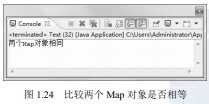
1.5 Map.get方法——返回指定键所映射的值
public static void main(String[] args) {
Map map = new HashMap(); //定义Map集合对象
map.put("apple", "新鲜的苹果"); //向集合中添加对象
map.put("computer", "配置优良的计算机");
map.put("book", "堆积成山的图书");
Object get = map.get("apple"); //获取指定键所映射的值
if (get instanceof String) { //判断键值是否为String类型
String value = (String) get; //获取指定的value值
System.out.println("在Map集合中键名apple的键值是:" + value); //将value值输出
}
}

1.6 Map.isEmpty方法——判断Map集合对象是否包含内容
public static void main(String[] args) {
System.out.println("创建Map集合对象");
Map map = new HashMap(); //定义Map集合对象
System.out.println("Map集合的isEmpty方法返回值是:" + map.isEmpty());
//判断集合是否为空
System.out.println("添加内容到Map集合");
map.put("apple", "新鲜的苹果"); //向集合中添加对象
map.put("computer", "配置优良的计算机");
map.put("book", "堆积成山的图书");
System.out.println("Map集合的isEmpty方法返回值是:" + map.isEmpty());
//判断集合是否为空
}
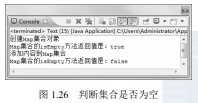
1.7 Map.keySet方法——获取Map集合的所有键名
public static void main(String[] args) {
Map map = new HashMap(); //定义Map集合
map.put("apple", "新鲜的苹果"); //向集合中添加元素
map.put("computer", "配置优良的计算机");
map.put("book", "堆积成山的图书");
map.put("time", new Date()); //向集合中添加时间对象
Set keySet = map.keySet(); //获取key集合对象
for (Object keyName : keySet) {
System.out.println("键名:" + keyName); //输出键名
}
}
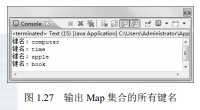
1.8 Map.put方法——获取Map集合的所有键名
put(K key, V value)
key:是要保存到Map集合中的键名。
value:是要保存到Map集合中对应键名的键值对象
public static void main(String[] args) throws InterruptedException {
Map map = new HashMap();
map.put("apple", "新鲜的苹果");
map.put("computer", "配置优良的计算机");
map.put("book", "堆积成山的图书");
map.put("time", new Date());
int size=map.size();
System.out.println("Map集合的大小为:"+size);
}
运行结果为“Map集合的大小为:4”。
1.9 Map.putAll方法——追加另一个Map对象到当前Map集合
putAll(Map<? extends K,? extends V> m)
m:一个Map集合对象。
public static void main(String[] args) {
Map map1 = new HashMap(); //定义Map集合对象
map1.put("apple", "新鲜的苹果"); //向集合中添加对象
map1.put("computer", "配置优良的计算机");
map1.put("book", "堆积成山的图书");
System.out.println("第一个Map集合大小为:"+map1.size()) //输出集合长度
Map map2 = new HashMap(); //定义Map集合map2
map2.put("apple2", "新鲜的苹果"); //向集合中添加对象
map2.put("computer2", "配置优良的计算机");
map2.put("book", "堆积成山的图书");
System.out.println("第二个Map集合大小为:"+map2.size()); //输出集合长度
System.out.println("把第二个Map集合添加到第一个Map集合中");
map1.putAll(map2); //将map2中的对象添加到map1中
System.out.println("整合后的第一个Map集合大小为:"+map1.size());
}
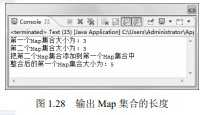
2.0 Map.values方法——获取Map集合中的所有键值对象
public static void main(String[] args) {
Map map = new HashMap(); //定义Map集合对象
map.put("apple", "新鲜的苹果"); //向集合中添加对象
map.put("computer", "配置优良的计算机");
map.put("book", "堆积成山的图书");
Collection values = map.values(); //获取Map集合的value集合
for (Object object : values) {
System.out.println("键值:" + object.toString()); //输出键值对象
}
}
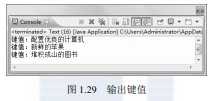
标签:
原文地址:http://www.cnblogs.com/zxg-6/p/5650991.html